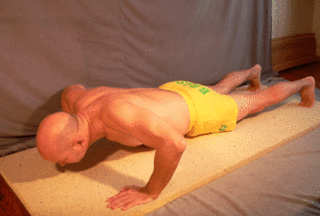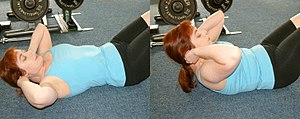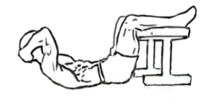
Calisthenics or callisthenics (/ˌkælɪsˈθɛnɪk/) is a form of strength training that utilizes an individual's body weight as resistance to perform multi-joint, compound movements with little or no equipment.

The push-up is a common calisthenics exercise beginning from the prone position. By raising and lowering the body using the arms, push-ups exercise the pectoral muscles, triceps, and anterior deltoids, with ancillary benefits to the rest of the deltoids, serratus anterior, coracobrachialis and the midsection as a whole. Push-ups are a basic exercise used in civilian athletic training or physical education and commonly in military physical training. They are also a common form of punishment used in the military, school sport, and some martial arts disciplines. Variations of push-ups, such as wide-arm push-ups, diamond push-ups target specific muscle groups and provide further challenges.

The sit-up is an abdominal endurance training exercise to strengthen, tighten and tone the abdominal muscles. It is similar to a crunch, but sit-ups have a fuller range of motion and condition additional muscles.

An exercise ball is a ball constructed of soft elastic, typically in 5 diameters of 10 cm increments, from 35 to 85 cm, and filled with air. The air pressure is changed by removing a valve stem and either filling with air or letting the ball deflate. It is most often used in physical therapy, athletic training and exercise. It can also be used for weight training.

The lying triceps extension, also known as skull crusher and French extension or French press, is a strength exercise used in many different forms of strength training. It is one of the most stimulating exercises to the entire triceps muscle group in the upper arm, and works the triceps from the elbow all the way to the latissimus dorsi. Due to its full use of the triceps muscle group, the lying triceps extensions are used by many as part of their training regimen.

In weight training, a kettlebell is a cast-iron or cast-steel ball with a handle attached to the top. It is used to perform many types of exercises, including ballistic exercises that combine cardiovascular, strength and flexibility training. Kettlebells are the primary equipment used in the weight-lifting sport of kettlebell lifting.
The vacuum exercise is an exercise which involves contracting some internal abdominal muscles, primarily the transverse abdominal muscle, and not as much the diaphragm.
Circuit training is a form of body conditioning that involves endurance training, resistance training, high-intensity aerobics, and exercises performed in a circuit, similar to high-intensity interval training. It targets strength building and muscular endurance. An exercise "circuit" is one completion of all set exercises in the program. When one circuit is completed, one begins the first exercise again for the next circuit. Traditionally, the time between exercises in circuit training is short and often with rapid movement to the next exercise.
Abdominal exercises are a type of strength exercise that affect the abdominal muscles. Human abdominal consist of four muscles which are the rectus abdomens, internal oblique, external oblique, and transversus abdominis. When performing abdominal exercises it is important to understand the effects, functions, the types of exercises, and think about how to perform this exercise safely.

The following outline is provided as an overview of and topical guide to exercise:

Spot reduction refers to the claim that fat in a certain area of the body can be targeted for reduction through exercise of specific muscles in that desired area. For example, exercising the abdominal muscles in an effort to lose weight in or around one's midsection. Fitness coaches and medical professionals as well as physiologists consider the claim to be disproved.

Diastasis recti, or rectus abdominis diastasis, is defined as a gap of about 2.7 cm or greater between the two sides of the rectus abdominis muscle. The distance between the right and left rectus abdominis muscles is created by the stretching of the linea alba, a connective collagen sheath created by the aponeurosis insertions of the transverse abdominis, internal oblique, and external oblique. This condition has no associated morbidity or mortality. Physical therapy is often required to repair this separation and surgery is an option for more severe cases. Standard exercise rarely results in complete healing of the separated muscles.

The Roman chair is a piece of exercise equipment. It is mainly used for the lower back, but can also target the buttocks, hamstrings, and abdomen. The definition of the equipment, and what 'Roman chair exercise' specifically means, is not clear.
In kinesiology, core stability is a person's ability to stabilize their core. Stability, in this context, should be considered as an ability to control the position and movement of the core. Thus, if a person has greater core stability, they have a greater level of control over the position and movement of this area of their body. The body's core is frequently involved in aiding other movements of the body, such as running; thus it is known that improving core stability also improves a person's ability to perform these other movements.

A power tower, also known as a knee raise station, and as a captain's chair, is a piece of exercise equipment that allows one to build upper body and abdominal muscle strength. When only the forearm pads alone are used for performing abdominal exercises, the power tower requires minimal arm strength as it is stable and movement occurs in the hips and torso. The equipment commonly has a backrest and forearm rests that form the chair, with vertical handles at the ends of the arm rests. The word "power" comes from the addition of other powerful arm exercises such as parallel horizontal handles for performing dips, a pull-up bar attached to the top for chin-ups and pull-ups, and push-up handles that are usually found on the bottom for Atlas ("deep") push-ups.

The burpee, a squat thrust with an additional stand between repetitions, is a full body exercise used in strength training. The movement itself is primarily an anaerobic exercise, but when done in succession over a longer period can be utilized as an aerobic exercise.

The plank is an isometric core strength exercise that involves maintaining a position similar to a push-up.
Split weight training, also known as split routine, or split workout routine, is a type of exercise workout routine. It is a workout regimen where different muscle groups are targeted on separate days, rather than exercising the entire body in a single session. This type of training allows for focused work on each muscle group while providing appropriate recovery time between training on the same muscle. This type of training is mostly used by bodybuilders and fitness trainers, while professional lifters typically avoid this approach.

Pelvic lift is an exercise to strengthen the lower back, glute muscles, lower abdominal muscles, and maintain hip muscle balance. It does not require weights, although they can be placed on the stomach.















